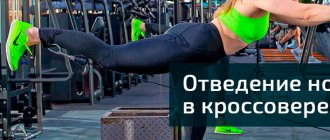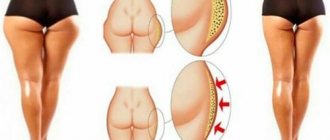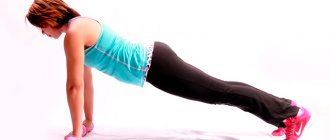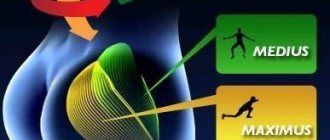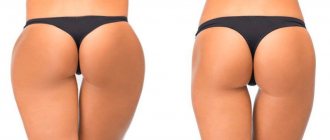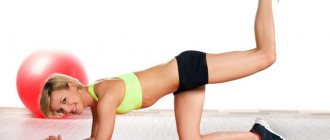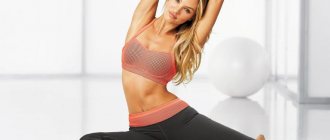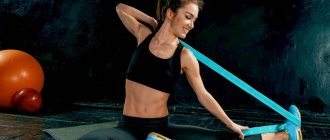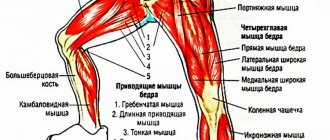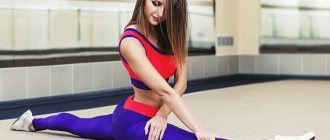Leg raises while lying on your side are an exercise for the core and obliques. It also engages the middle bundle of the gluteal muscles. The movement includes the hips as well. The exercise is used both in gymnastics, Pilates and shaping, and as an additional exercise in fitness. Many people say that double leg lifts can create a waist, but this is actually not true. The exercise is recommended as formative and builds general physical fitness.
Swing your legs while lying on your side
This option uses the gluteus medius muscle, but depending on the offset of the hip from the center, the load on the buttocks is also distributed differently. In the classic version, you need to lie on your side, tightening your abdominal and thigh muscles, and place your upper leg strictly above your lower leg.
The swing is performed in any of the options while exhaling, while the hip rises no higher than 45 degrees. It is important to feel constant tension in the side of the buttocks. And in order to slightly shift the load on the upper part of the gluteus maximus muscle, the thigh must be moved back a little, but without bending the lower back too much.
You need to perform lifts on each side 15-30 times until you feel a burning sensation in the muscles.
Leg adduction while lying on your side
And this option develops the adductor surface of the thigh. While lying on your side, your lower leg should be brought forward approximately 45 degrees. The upper leg can be placed on the floor with the knee bent, or held in a vertical position. In the latter option, the lower leg will need to be brought forward at a right angle. This option is more difficult and requires a good balance.
Consider the option with a foot rest. When swinging your leg, it is important not to raise your leg too high, so as not to roll onto your lower back; the load should be felt in the inner thigh. Swings are also performed on each side for 15 to 30 repetitions.
The barbell glute bridge is an exercise you need to start doing NOW.
You may have seen this move in a yoga class—but it shouldn't be underestimated. If you've ever practiced yoga before, you're probably familiar with the glute bridge. You lie on your back with your legs bent at 90 degrees, pressing your heels into the floor, lifting your hips to form a straight line from your shoulders to your knees.
Yogis typically hold this position for a time or a certain number of breaths. And if you're new to working out, this is a great place to start getting a better butt.
But after some time, the stimulating effect on the buttocks subsides, since the movement is carried out only with body weight. So if you want to continue adding more definition and curves to your butt, you need to increase the intensity.
In the first installment of a series of articles about the 10 best exercises for a toned butt, a better butt, a super-secure back, and a better athletic (and sexy) figure, Contreras demonstrated the mother of all butt-improving exercises, the barbell butt lift (see below for how to do it). Here).
The barbell glute bridge is a great variation of this movement, the main difference being that it is performed on the floor instead of lifting your upper back onto a bench. In addition, it causes activation of the glutes and hamstrings at a similar level to the barbell glute lift, but engages the quadriceps less.
In addition, the range of motion in the gluteal bridge is less than when performing a buttock raise with the upper back resting on the bench. That's why this option also tends to be a good starting point for advanced glute training for beginners or people who don't have access to the right bench height to get their shoulders high enough to perform a bench-supported pelvic lift.
However, there is a neat trick you can use to increase the range of motion of your glute bridge. Bret recommends using 10kg pancakes (which have a smaller radius) instead of the larger 15/20/25kg pancakes.
What about a mini tourniquet wrapped around both legs just above the knees? This both locks in form (many students with weak glutes find their knees sink inward when doing glute bridges or squats) and improves glute activation by forcing you to push your knees outward against the resistance of the band throughout the exercise. Any mini harness will work.
To perform the exercise like a pro, Brett recommends:
- Place a barbell with a wrapped barbell like a squat sponge just above your pubic bone.
- Tuck or tuck your chin into the top of your chest and press your lower back toward the floor before beginning the reps.
- Lift your toes up off the floor and push your heels off the floor for maximum glute activation.
Bret recommends starting with 3 sets of 20 reps with a light weight on the barbell (or just your body weight if necessary). Continue to progress using heavier weights for 3 sets of 8-12 reps.
Swing your legs apart while lying on your back
In this embodiment, the adductor muscles of the thigh will work. To do this, you need to lie on your back, place your arms along your body, and raise your legs to a vertical position. As you inhale, you need to move your legs to the sides, but carefully, without tearing or stretching the muscles as much as possible (do not confuse this with stretching). As you exhale, use your adductor muscles to bring your legs together.
Swing your leg while standing forward
Swinging your leg forward while standing engages the extensor muscles or quadriceps. This option is not the most effective for this area, but by including it in a complex of various swings for all muscle groups, you can significantly increase the fat-burning effect of the training by performing exercises without pauses.
Standing straight, placing your hands on your waist or leaning against a wall, exhale and swing your leg forward without rounding your back. There is no need to try to lift your leg high. Perform the movements without swaying, and so on each side for 15-30 swings.
Advantages and disadvantages
Pros:
- Raising your legs to the bar develops strength and endurance of the rectus abdominis muscle, especially its lower part. The technique also affects the deep abdominal muscles, which are less likely to be activated in simple crunches.
- Since the technique is complex, the exercise will allow you to make progress in developing your abdominal muscles. This is also facilitated by stabilization of the position by the core muscles, which will eliminate unnecessary swaying and inertia.
- Bringing your legs to the bar allows you to not only get six-pack abs, but also significantly increase their strength, preparing you for complex basic exercises with weights.
- There are simplified variations of the exercise that allow beginners to eventually prepare for a full leg raise that touches the bar.
- Strengthens the grip and endurance of the accessory muscles involved in hanging. Increases the strength of ligaments and tendons.
Minuses:
- Raising the legs to the horizontal bar is not suitable for beginner athletes at the initial stage of training, since they require not only trained abdominal muscles, but also strong stabilizer muscles and grip, which develop over time.
- Since the technique is difficult, untrained muscles have to perform the movement due to inertia and jerking, which leads to injuries.
- The technique may cause discomfort to the hands, shoulders and arms. Most often, a weak ligamentous apparatus does not allow you to fully train the target muscles, since the arms get tired before the abdominal muscles become tired.
- High risk of falling due to slipping palms. You can protect yourself by using magnesium or special straps.
Swing your leg to the side while standing
When swinging to the side, the gluteus medius and minimus muscles are activated. This is an excellent option for shaping the upper part of the buttocks, making it more rounded and spherical when viewed from the side.
To perform swings, place your hands on your belt or grab a stable support. Exhale and move your leg to the side, without performing sudden or amplitude movements. It is enough to raise your leg 45 degrees up, feeling the work of the gluteal muscles. Just like all options, perform a large number of repetitions on each side until you feel a burning sensation in the muscles.
Using weights
Once you have fully mastered the exercise and are able to perform the maximum number of repetitions, the leg swings will begin to lose their effectiveness. To avoid this, try more difficult versions of the swing. Specifically, use weights.
Performed with weights.
Wear weights weighing 0.5–1 kg on your feet. This will make it more difficult to perform swings and will force the muscles to work even more intensely. You can use a rubber expander or tape for the same purposes.
Leg swings are an indispensable exercise for pumping up the buttocks. Its regular implementation will significantly improve the shape of the lower body and bring the muscles into the necessary tone.
Swing your leg back while standing
When you move your leg back, the gluteus maximus muscle is activated, both the outer and deep layers. This is one of the best exercises for the gluteus maximus, which affects size. The exercise can be performed with your own weight, as well as with the help of weights and a fitness band, which will significantly increase the effectiveness of the exercise.
To do this at home, place your hands on the wall at chest level, step back a little so that your torso can lean forward slightly. As you exhale, lift one leg back, without lifting it too high, that is, not above the horizontal line. As you inhale, slowly lower your leg, but do not touch the floor with your foot. Perform the same number of repetitions on each side.
Secrets of proper technique
When performing the exercise, you should be guided by a number of principles:
It is necessary to warm up before performing the exercise
Particular attention should be paid to the lower back. It's worth starting with a little weight. It is recommended to use a dumbbell weighing 3–5 kilograms, gradually increasing the load
The exercise is most effective when combined with other movements. If you use heavy weights and low repetitions, you can achieve larger abdominal and oblique muscles, which will widen your waist. If you have problems with the spine, then it is better to refuse to perform bends with a dumbbell. When losing weight, a high-repetition version of the exercise is recommended; particular effectiveness is observed when the movement is included in supersets.
It is recommended to use a dumbbell weighing 3–5 kilograms, gradually increasing the load. The exercise is most effective when combined with other movements. If you use heavy weights and low repetitions, you can achieve larger abdominal and oblique muscles, which will widen your waist. If you have problems with the spine, then it is better to refuse to perform bends with a dumbbell. When losing weight, a multi-repetition version of the exercise is recommended; particular effectiveness is observed when the movement is included in supersets.
The main point is compliance with the exercise technique. If you have questions, it is better to contact a trainer or study additional materials online.
You can also use a kettlebell as a weight, but the minimum weight of a kettlebell is usually 16 kilograms, so it’s better to pay attention to dumbbells first
Swing your leg back while on all fours
The target muscle is the gluteus maximus. Swings can be performed in two versions - with a straight or bent leg. Regardless of the option chosen, the effect will be achieved when a burning sensation occurs in the buttocks.
In order to prevent excessive deflection in the lower back, it is better to perform such swings on the forearms, placing the elbows under the shoulder joints. The knees must be positioned strictly under the hip joint, slightly apart to the sides. One leg swing is performed while exhaling using the gluteus maximus. Tighten your abs to avoid excessive arching in the lumbar region. Switch sides and perform the same number of repetitions.
Read more about back leg swings on the ground →
Swing your leg to the side while on all fours
When moving the leg to the side, the gluteus medius muscle is loaded to a greater extent. Of course, this does not mean that the large and small groups do not work at all, it’s just that the main load in the lateral leads still falls on the middle group.
From the previous position: on all fours, the swing is performed while exhaling with the leg bent to the side. In this case, the torso should not fall to the side, and the back should not take unnecessary bends, so always tense your abdominal muscles for better fixation of the spine. As usual, swings are performed on each side. You can also swing with a straight leg, but this option is much more difficult and inconvenient.
Benefit
For slimming thighs and thighs
Do swings help you lose weight in your legs? Indirectly, yes, like absolutely any activity, including walking, making love, and even picking your nose, if it helps you create a calorie deficit

